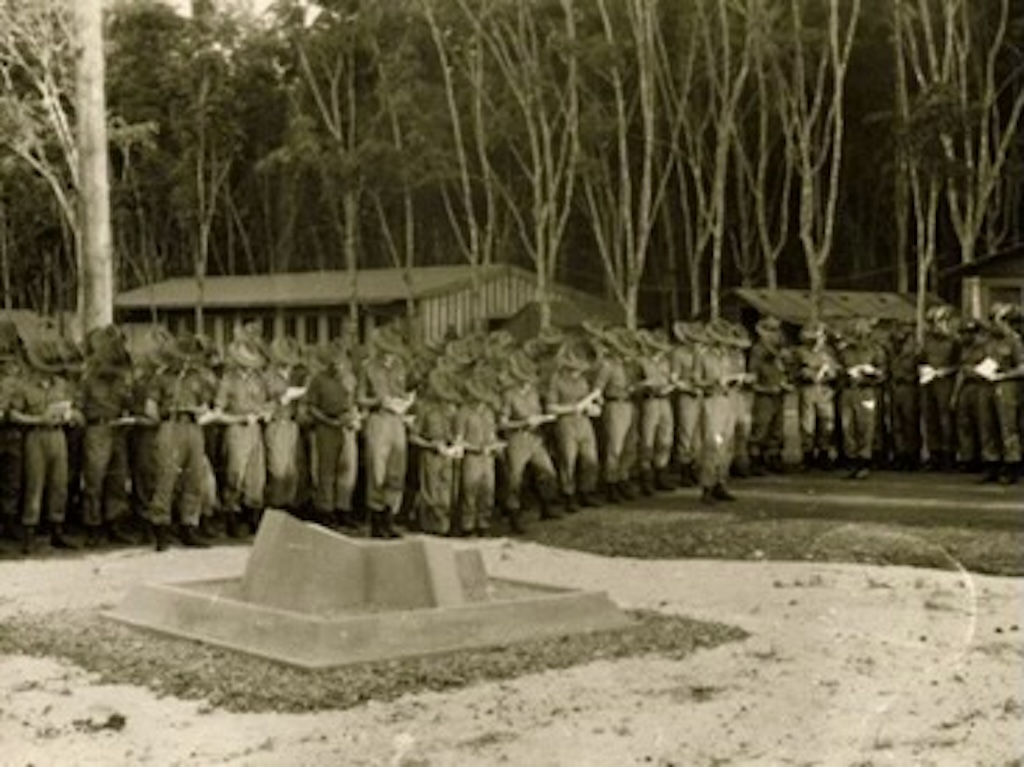
Following the death in South Vietnam of Private Ray Cox on 28 December 1968, a funeral procession, with the coffin on the gun carriage, moves out of St Saviour’s Cathedral, Goulburn. Photo: Australian Military Forces/Rocky Hill War Memorial Museum.
A television from the 1960s and 70s is an unlikely yet key object to place within an exhibition portraying the Vietnam War.
The early model television will carry images, as it did back in 1962 to 1975, of the conflict abroad during the exhibition which opens at the Rocky Hill War Memorial Museum in Goulburn on 16 August.
Goulburn Mulwaree Council Museums Coordinator Justin Croft says the television, provided by one of the museum’s volunteers, brought images right into people’s homes.
“That’s why tensions started flying because people in previous wars hadn’t been able to see it, or it had been edited by the government,” he said.
“The Second World War [film footage] was propaganda. If they had television back in the First World War it would not have lasted that long, the amount of carnage that was seen,” he said. “People actually saw the carnage for the first time [from Vietnam] because journalists were going over.”
People were horrified. Anti-war protests started and Goulburn people joined the outcry.
“It wasn’t just in Sydney, Brisbane and Melbourne; there were smaller ones as well,” Justin said. Also recorded for the exhibition is a ‘Save Our Sons’ campaign set up by women’s groups around Australia to try to stop the war.
The Moratorium movement, which gained momentum in 1970, called for the immediate withdrawal of Australian troops from Vietnam, leading to large-scale protests across the country.
Sixty young people protested in Goulburn on 2 June 1971, many from the Goulburn Teachers College.
The families of several service men and women have donated photos, written correspondence and uniforms for the exhibition, which will be launched by curator, Julianne Salway. Goulburn RSL vice-president, Bill White, who went to Vietnam as a conscript, will speak at the opening.
Conscripted to serve in 1967, Private Ray Cox returned home to Goulburn for a surprise visit and announced his arrival by rocking the family’s iron roof in Ellesmere Street, his sister Margaret recounted to Region in 2022. Coming from a family of nine girls and two boys, his brother and sisters were all thrilled to see him. Sadly, he was killed in action later, on 28 December 1968, after triggering a booby trap. The 22-year-old soldier had only six weeks remaining of his service.
Several photographs and his call up notice from 7 April 1967 are among items donated for the exhibition.

A larger memorial service for fallen members of the 1st Battalion, including Raymond John Cox. It is believed to have been held at Nui Dat, Vietnam. Photo: Rocky Hill War Memorial Museum.
Major John Whipp, formerly of Goulburn, who was stationed in Vietnam from 1972 as a warrant officer and later promoted to Major, has donated collection items to the museum including camping equipment and military uniforms.
He served two tours of duty in Vietnam, the first with the Australian forces and the second with the Australian Army Training Team.
He talks of his experience leaving home and recovering from the war on his return.
“It would have been horrible, especially for the lads conscripted, they didn’t get a choice, did they?” Justin said.
The family of former private Daniel Wyborn, who were living in Goulburn during the war years have supplied many photographs.
“When he was not fighting he was going around taking pictures of the camps, and the locals so it is a good historical record,” Justin said.
The museum also has an Australian Army Training Team flag, a Vietcong flag, uniforms, camp stoves and radios. It provides links to newspaper articles recounting a soldier was killed in December 1968 when a tank hit a mine, and several others being wounded including Lance Corporal Peter James Kercher, 23, single, of Goulburn. In April 1970, Norm Barnwell, a teacher at St. Patrick’s College, and a sponsor of the local Moratorium campaign, was suspended for wearing his Moratorium badge at school.
Museum staff are trying to obtain Australian music from the era, rather than relying on popular culture that has left many people with America’s view of what happened.
The exhibition chronicles the stages of government actions, the acts of parliament introduced, conscription and the ‘television war’. The Australian Government gradually changed its stand and began withdrawing troops until then prime minister Gough Whitlam ordered the last unit out.
The exhibition will remain open until November 2025. The memorial’s centenary will be celebrated in December 2025.
“Vietnam War: Honouring Service and Reflecting on Social Change,” exhibition on Friday 16 August at 3 pm at Rocky Hill War Memorial Museum, Memorial Road, Goulburn.









